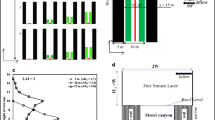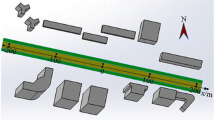Abstract
Particles emitted from vehicles can threaten human health. Therefore the investigations about the particle dispersion characteristics inside the street canyon are of significance. For the current work, the airflow fields and the particle movement inside an isolated street canyon with three aspect ratios under perpendicular wind direction and two typical wind speeds are studied numerically, for which the particle distributions are obtained by solving the drift-flux model. The conclusions demonstrate that the trees will result in the particles gathering. However, the particle deposition fluxes on the trees are so small which cannot effectively remove the particles from the ambient air. Besides, the vehicles tend to cluster particles around the street axis and slow down the dispersion to the curbside buildings. Therefore, the vehicles should not be ignored in the numerical models, especially for the cases in the wind direction of 90°. Moreover the cases with the aspect ratio of 0.5 are more sensitive to the effects of trees and vehicles. The shop vendors expose to the highest particle concentrations in most of the scenarios.
Similar content being viewed by others
References
ANSYS (2010). ANSYS FLUENT Theory Guide, Canonsburg, PA, USA: ANSYS Inc.
Amorim JH, Rodrigues V, Tavares R, Valente J, Borrego C (2013). CFD modelling of the aerodynamic effect of trees on urban air pollution dispersion. Science of Total Environment, 461–462: 541–551.
Ayo SA, Mohd-Ghazali N, Mansor S (2015). Outdoor ventilation performance of various configurations of a layout of two adjacent buildings under isothermal conditions. Building Simulation, 8: 81–98.
Buccolieri R, Gromke C, Di Sabatino S, Ruck B (2009). Aerodynamic effects of trees on pollutant concentration in street canyons. Science of Total Environment, 407: 5247–5256.
Chau CK, Tu EY, Chan DWT, Burnett J (2002). Estimating the total exposure to air pollutants for different population age groups in Hong Kong. Environment International, 27: 617–630.
Chen F, Yu SCM, Lai ACK (2006). Modeling particle distribution and deposition in indoor environments with a new drift-flux model. Atmospheric Environment, 40: 357–367.
Chen Y, Ebenstein A, Greenstone M, Li HB (2013). Evidence on the impact of sustained exposure to air pollution on life expectancy from China’s Huai River policy. PNAS, 110: 12936–12941.
Cheng WC, Liu C-H, Leung DYC (2009). On the comparison of the ventilation performance of street canyons of different aspect ratios and Richardson number. Building Simulation, 2: 53–61.
COST (2011). COST Action 732. Quality assurance and improvement of micro-scale meteorological models. Available at http://www.mi.uni-hamburg.de/Home.484.0.html.
Cui PY, Li Z, Tao WQ (2016). Buoyancy flows and pollutant dispersion through different scale urban areas: CFD simulations and windtunnel measurements. Building and Environment, 104: 76–91.
Dockery DW, Pope CA, Xu X, Spengler JD, Ware JH, Fay ME, Ferris BG Jr, Speizer FE (1993). An association between air pollution and mortality in six U.S. cities. The New England Journal of Medicine, 329: 1753–1759.
Duan N (1982). Models for human exposure to air pollution. Environment International, 8: 305–309.
Gao NP, Niu JL, Perino M, Heiselberg P (2008). The airborne transmission of infection between flats in high-rise residential buildings: Tracer gas simulation, Building and Environment, 43: 1805–1817.
Green SR (1992). Modelling turbulent air flow in a stand of widelyspaced trees. The PHOENICS Journal of Computational Fluid Dynamics and Its Applications, 5: 294–312.
Gromke C, Buccolieri R, Di Sabatino S, Ruck B (2008). Dispersion study in a street canyon with tree planting by means of wind tunnel and numerical investigations—Evaluation of CFD data with experimental data. Atmospheric Environment, 42: 8640–8650.
Gromke C, Ruck B (2012). Pollutant concentrations in street canyons of different aspect ratio with avenues of trees for various wind directions. Boundary-Layer Meteorology, 144: 41–64.
Jacobson MZ (2005). Fundamentals of Atmospheric Modeling, 2nd edn. Cambridge, UK: Cambridge University Press.
Ji W, Zhao B (2014). Numerical study of the effects of trees on outdoor particle concentration distributions. Building Simulation, 7: 417–427.
Jin S, Guo J, Wheeler S, Kan L, Che S (2014). Evaluation of impacts of trees on PM2.5 dispersion in urban streets. Atmospheric Environment, 99: 277–287.
Kaimal JC, Finnigan JJ (1994). Atmospheric Boundary Layer Flows: Their Structure and Measurement. Oxford: Oxford University Press.
Klein PM, Galvez JM (2015). Flow and turbulence characteristics in a suburban street canyon. Environmental Fluid Mechanics, 15: 419–438.
Klepeis NE, Nelson WC, Ott WR, Robinson JP, Tsang AM, Switzer P, Behar JV, Hern SC, Engelmann WH (2001). The National Human Activity Pattern Survey (NHAPS): A resource for assessing exposure to environmental pollutants. Journal of Exposure Analysis and Environmental Epidemiology, 11: 231–252.
Lai ACK, Nazaroff WW (2000). Modeling indoor particle deposition from turbulent flow onto smooth surfaces. Journal of Aerosol Science, 31: 463–476.
Lalic B, Mihailovic DT (2004). An empirical relation describing leafarea density inside the forest for environmental modeling. Journal of Applied Meteorology and Climatology, 43: 641–645.
Launder BE, Spalding DB (1974). The numerical computation of turbulent flows. Computer Methods in Applied Mechanics and Engineering, 3: 269–289.
Liu J, Niu J (2016). CFD simulation of the wind environment around an isolated high-rise building: An evaluation of SRANS, LES and DES models. Building and Environment, 96: 91–106
Liu K, Zhou Q-b, Wu W-b, Xia T, Tang H-j (2016). Estimating the crop leaf area index using hyperspectral remote sensing. Journal of Integrative Agriculture, 15: 475–491.
Lu W-Z, Xue Y, He H-d (2014). Detrended fluctuation analysis of particle number concentrations on roadsides in Hong Kong. Building and Environment, 82: 580–587
Memon RA, Leung DYC, Liu CH (2010). Effects of building aspect ratio and wind speed on air temperatures in urban-like street canyons. Building and Environment, 45: 176–188.
Nazaroff WW (2004). Indoor particle dynamics. Indoor Air, 14: 175–183.
Ng WY, Chau CK (2014). A modeling investigation of the impact of street and building configurations on personal air pollutant exposure in isolated deep urban canyons. Science of Total Environment, 468: 429–448.
Nowak DJ, Hirabayashi S, Bodine A, Hoehn R (2013). Modeled PM2.5 removal by trees in ten U.S. cities and associated health effects. Environmental Pollution, 178: 395–402.
Ott WR (1982). Concept of human exposure to air pollution. Environmental International, 7: 179–186.
Petroff A, Mailliat A, Amielh M, Anselmet F (2008). Aerosol dry deposition on vegetative canopies. Part II: A new modelling approach and applications. Atmospheric Environment, 42: 3654–3683.
Petroff A, Zhang L, Pryor SC, Belot Y (2009). An extended dry deposition model for aerosols onto broadleaf canopies. Journal of Aerosol Science, 40: 218–240.
Salim SM, Buccolieri R, Chan A, Di Sabatino S (2011). Numerical simulation of atmospheric pollutant dispersion in an urban street canyon: Comparison between RANS and LES. Journal of Wind Engineering and Industrial Aerodynamics, 99: 103–113.
Santiago JL, Martín F, Cuerva A, Bezdenejnykh N, Sanz-Andrés A (2007). Experimental and numerical study of wind flow behind windbreaks. Atmospheric Environment, 41: 6406–6420.
Scungio M, Arpino F, Stabile L, Buonanno G (2013). Numerical Simulation of Ultrafine Particle Dispersion in Urban Street Canyons with the Spalart-Allmaras Turbulence Model. Aerosol and Air Quality Research, 13: 1423–1437.
Scungio M, Arpino F, Cortellessa G, Buonanno G (2015). Detached eddy simulation of turbulent flow in isolated street canyons of different aspect ratios. Atmospheric Pollution Research, 6: 351–364.
Shen X, Yao Z, Huo H, He K, Zhang Y, Liu H, Ye Y (2014). PM2.5 emissions from light-duty gasoline vehicles in Beijing, China. Science of Total Environment, 487: 521–527.
Steffens JT, Heist DK, Perry SG, Zhang KM (2013). Modeling the effects of a solid barrier on pollutant dispersion under various atmospheric stability conditions. Atmospheric Environment, 69: 76–85.
Steffens JT, Wang YJ, Zhang KM (2012). Exploration of effects of a vegetation barrier on particle size distributions in a near-road environment. Atmospheric Environment, 50: 120–128.
Thom AS (1972). Momentum, mass and heat exchange of vegetation. Quarterly Journal of the Royal Meteorological Society, 98: 124–134.
Vos PEJ, Maiheu B, Vankerkom J, Janssen S (2013). Improving local air quality in cities: To tree or not to tree? Environmental Pollution, 183: 113–122.
Wang YJ, DenBleyker A, McDonald-Buller E, Allen D, Zhang KM (2011). Modeling the chemical evolution of nitrogen oxides near roadways. Atmospheric Environment, 45: 43–52.
Wang YJ, Zhang KM (2009). Modeling near-road air quality using a computational fluid dynamics model, CFD-VIT-RIT. Environmental Science and Technology, 43: 7778–7783.
Wilson JD (2004). Oblique, stratified winds about a shelter fence. Part I: Measurements. Journal of Applied Meteorology and Climatology, 43: 1149–1167.
Xie X, Huang Z, Wang J, Xie Z (2005). The impact of solar radiation and street layout on pollutant dispersion in street canyon. Building and Environment, 40: 201–212.
Yang F, Gao Y, Zhong K, Kang Y (2016). Impacts of cross-ventilation on the air quality in street canyons with different buildingarrangements. Building and Environment, 104: 1–12.
Yang F, Kang Y, Gao Y, Zhong K (2015). Numerical simulations of the effect of outdoor pollutants on indoor air quality of buildings next to a street canyon. Building and Environment, 87: 10–22.
Zhang L, Gong S, Padro J, Barrie L (2001). A size-segregated particle dry deposition scheme for an atmospheric aerosol module. Atmospheric Environment, 35: 549–560.
Acknowledgements
The financial supports for this research, from the National Natural Science Foundation of China (No. 51476055) and the National Basic Research Program of China (No. 2015CB251503), are gratefully acknowledged.
Author information
Authors and Affiliations
Corresponding author
Rights and permissions
About this article
Cite this article
Jin, X., Yang, L., Du, X. et al. Transport characteristics of PM2.5 inside urban street canyons: The effects of trees and vehicles. Build. Simul. 10, 337–350 (2017). https://doi.org/10.1007/s12273-016-0324-1
Received:
Revised:
Accepted:
Published:
Issue Date:
DOI: https://doi.org/10.1007/s12273-016-0324-1




